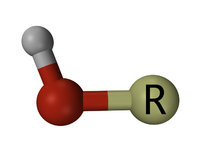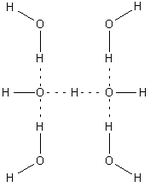博文
知道的和不知道的:google在学术方面的应用也很强悍
|||
OH的与化学相关的搜索结果:
OH (chemistry), hydroxyl functional group
OH− (chemistry), hydroxide 【氢氧化物:含氢氧基化合物的一种化学化合物】
•OH (chemistry), hydroxyl radical 【羟(基)氢氧基;radical-根, 基, 原子团】
OH (chemistry), the functional alcohol group in a molecule, e.g. CH3CH2OH






H3O2−=H2O+HO-
(1) -OH covalently-bound group -OH
A hydroxyl is a chemical functional group containing an oxygen atom connected by a covalent bond to a hydrogen atom, a pairing that can be simply understood as a substructure of the water molecule.
When it appears, it imparts【分给, 传授】 to chemical structures some of the reactive and interactive properties of the -OH (not to be confused with the hydroxide ion OH-) of water (ionizability, hydrogen bonding, etc.).
The neutral form of the hydroxyl group is a hydroxyl radical.
The anion form, (OH−) is called the hydroxide anion【阴离子】; it bears a single negative charge largely residing on the more electronegative oxygen.
Hydroxyl groups can form hydrogen bonds with water molecules, helping to dissolve organic compounds such as sugars. 【糖溶于水是通过氢键作用?】
It is typically a polar group as a result of the electrons spending more time near the electronegative oxygen atom.【对极性基团解释的好啊】[1]
One cannot overstate its centrality in all chemistry, especially because of its necessary targeting in organic synthesis, its roles in enzyme catalysis and inhibition, and in the formation of biological structures, all because of its hydrogen bonding capability.
This capability underlies protein-ligand【配合基[体], 向心配合(价)体】 interactions, and imparts water solubility and internal structural stability to macromolecule
(2)Hydroxyl radical electrically neutral compound •HO
Hydroxyl radicals are highly reactive and undergo chemical reactions that make them short-lived. When biological systems are exposed to hydroxyl radicals, they can cause damage to cells, including those in humans, where they react with DNA, lipids, and proteins.
The hydroxyl radical, •HO, is the neutral form of the hydroxide ion(HO–).
Hydroxyl radicals are highly reactive and consequently short-lived;
however, they form an important part of radical chemistry. Most notably hydroxyl radicals are produced from the decomposition of hydroperoxides (ROHO)【过氧羟自由基】 or, in atmospheric chemistry, by the reaction ofexcited atomic oxygen with water.
It is also an important radical formed in radiation chemistry, since it leads to the formation of hydrogen peroxide and oxygen, which can enhance corrosion and SCC in coolant systems subjected to radioactive environments.
Hydroxyl radicals are also produced during UV-light dissociation of H2O2(suggested in 1879) and likely in Fenton chemistry, where trace amounts of reduced transition metals catalyze peroxide-mediated oxidations of organic compounds.
Energy levels[edit]
•HO is a diatomic molecule. The electronic angular momentum along the molecular axis is +1 or -1, and the electronic spin angular momentum S=1/2.
Because of the orbit-spin coupling, the spin angular momentum can be oriented in parallel or anti parallel directions to the orbital angular momentum, producing the splitting into Π1/2 and Π3/2 states. The 2Π3/2 ground state of •HO is split by lambda doubling interaction (an interaction between the nuclei rotation and the unpaired electron motion around its orbit). Hyperfine interaction with the unpaired spin of the proton further splits the levels.
(3)Hydroxide electrically neutral compound •HO
Hydroxide is a diatomic anion with chemical formula OH−.
It consists of an oxygen and a hydrogen atom held together by a covalent bond, and carries a negative electric charge.
It is an important but usually minor constituent of water.
It functions as a base, a ligand, anucleophile and a catalyst.
A hydroxide attached to a strongly electropositive center may itself dissociate,[citation needed] liberating a hydrogen cation (H+), making the parent compound an acid.
The corresponding electrically neutral compound •HO is the hydroxyl radical.
The corresponding covalently-bound group -OH of atoms is the hydroxyl group.
Hydroxide ion and hydroxyl group are nucleophiles and can act as a catalyst in organic chemistry.
Many inorganic substances which bear the word "hydroxide" in their names are not ionic compounds of the hydroxide ion, but covalent compounds which contain hydroxyl groups.
The hydroxide ion is a natural constituent of water, because of the self-ionization reaction:[1]
H+ + OH− ![]() H2O
H2O
The equilibrium constant for this reaction, defined as
Kw = [H+][OH−][note 1]
has a value close to 10−14 at 25 °C, so the concentration of hydroxide ions in pure water is close to 10−7 mol∙dm−3, in order to satisfy the equal charge constraint.
In aqueous solution both hydrogen and hydroxide ions are strongly solvated, with hydrogen bonds between oxygen and hydrogen atoms.
Indeed, the bihydroxide ion H3O2−has been characterized in the solid state. This compound is centrosymmetric and has a very short hydrogen bond (114.5 pm) that is similar to the length in the bifluorideion HF2− (114 pm).[2]
In aqueous solution the hydroxide ion forms strong hydrogen bonds with water molecules.
A consequence of this is that concentrated solutions of sodium hydroxide have high viscosity【粘质, 粘性】 due to the formation of an extended network of hydrogen bonds as in hydrogen fluoride solutions.
In solution, exposed to air, the hydroxide ion reacts rapidly with atmospheric carbon dioxide, acting as an acid, to form, initially, the bicarbonate ion.
OH− + CO2 ![]() HCO3−
HCO3−
2.
2. Vibrational spectra[edit]
The infrared spectra of compounds containing the OH functional group have strong absorption bands in the region centered around 3500 cm−1.[6]
The high frequency of molecular vibration is a consequence of the small mass of the hydrogen atom as compared to the mass of the oxygen atom and this makes detection of hydroxyl groups by infrared spectroscopy relatively easy.
A band due to an OH group tends to be sharp.
However, the band width increases when the OH group is involved in hydrogen bonding.
A water molecule has an HOH bending mode at about 1600 cm−1, so the absence of this band can be used to distinguish an OH group from a water molecule.
3.
Organic peroxide
Organic peroxides are organic compounds containing the peroxide functional group(ROOR'). If the R' is hydrogen, the compound is called an organic hydroperoxide.Peresters have general structure RC(O)OOR. The O-O bond easily breaks and formsfree radicals of the form RO·. Thus, organic peroxides are useful as initiators for some types of polymerisation, such as the epoxy resins used in glass-reinforced plastics. MEKP and benzoyl peroxide are commonly used for this purpose. However, the same property also means that organic peroxides can either intentionally or unintentionally initiate explosive polymerisation in materials with unsaturatedchemical bonds, and this process has been used in explosives. Organic peroxides, like their inorganic counterparts, are powerful bleaching agents.[1]
The O-O bond distance in peroxides is about 1.45 A and the R-O-O angles (R = H, C) are about 110° (water-like). Characteristically, the C-O-O-R (R = H, C) dihedral angles are about 120°. The O-O bond is relatively weak, with a bond dissociation energy of 45 - 50 kcal/mol, less than half the strengths of C-C, C-H, and C-O bonds.[2]
The oxidizing tendency of peroxides is related to the electronegativity of the substituents. Electrophilic peroxides are stronger O-atom transfer agents. For hydroperoxides, the O-atom donor tendency correlates with the acidity of the O-H bond. Thus, the order of oxidizing power is CF3CO3H > CH3CO3H > H2O2.
Active Oxygen in Peroxides[edit]
Each peroxy group is considered to contain one active oxygen atom. The concept of active oxygen content is useful for comparing the relative concentration of peroxy groups in formulations, which is related to the energy content. In general, energy content increases with active oxygen content and thus, the higher the molecular weight of the organic groups, the lower the energy content and, usually, the lower the hazard.
The term ACTIVE OXYGEN is used to specify the amount of peroxide present in any organic peroxide formulation. One of the oxygen atoms in each peroxide group is considered “active”. The theoretical amount of active oxygen can be described by the following equation.[3]
A[O]Theoretical (%) = [(16*p)/m]*100
Where p = number of peroxide groups in the molecule and m = molecular weight of the pure peroxide
Organic peroxides are often sold as formulations which include one or more phlegmatizing agents. That is, for safety sake or performance benefits the properties of an organic peroxide formulation are commonly modified by the use of additives to phlegmatize (desensitize), stabilize, or otherwise enhance the organic peroxide for commercial use. Commercial formulations occasionally consist of mixtures of organic peroxides which may or may not be phlegmatized.
Organic peroxides may be in the solid or liquid state. There are no organic peroxides in the vapor state. Occasionally liquid organic peroxides are desensitized by mixing with solid materials so that the mixture behaves as if it is a solid.
Thermal Decomposition of Organic Peroxides[edit]
Unlike most other chemicals, the purpose of a peroxide is to decompose. In doing so it generates useful radicals that can initiate polymerization to make polymers, modify polymers by grafting or visbreaking, or crosslink polymers to create a thermoset. When used for these purposes, the peroxide is highly diluted, so the heat generated by the exothermic decomposition is safely absorbed by the surrounding medium (e.g. polymer compound or emulsion). But when a peroxide is in a more pure form, the heat evolved by its decomposition may not dissipate as quickly as it is generated which can result in increasing temperature which further intensifies the rate of exothermic decomposition. This can create a dangerous situation known as a self-accelerating decomposition.
https://blog.sciencenet.cn/blog-567091-733445.html
上一篇:SciFinder:注册与使用解读
下一篇:规范学术行为之CITI